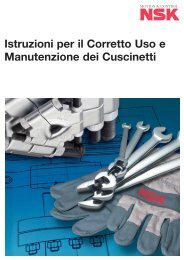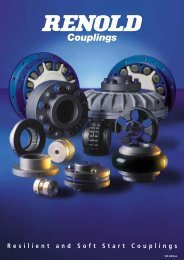TW Series - Single Reduction - Selection Data - Bianchi Cuscinetti
TW Series - Single Reduction - Selection Data - Bianchi Cuscinetti
TW Series - Single Reduction - Selection Data - Bianchi Cuscinetti
You also want an ePaper? Increase the reach of your titles
YUMPU automatically turns print PDFs into web optimized ePapers that Google loves.
To select a worm gear unit the following<br />
basic information must be known and, if we<br />
are to make the selection, should be<br />
submitted in full to our Technical Sales<br />
Department.<br />
Power<br />
a) Prime mover, type and output power (kW).<br />
b) Gear unit input and output power<br />
required (kW).<br />
c) For input speeds below 250 rev/min<br />
consult our Technical Sales Department<br />
giving details of required output torque (Nm)<br />
and diameter of driven shaft (mm).<br />
Speed<br />
Gear unit input and output rev/min.<br />
Duty<br />
a) The characteristics of the drive eg. degree<br />
of impulsiveness of the driven load.<br />
b) Duration of service in hours/day.<br />
c) Starting load (kW) and number of starts<br />
per day.<br />
d) For intermittent duty, reversing or shock<br />
loading, state normal power (kW) and<br />
frequency.<br />
e) Disposition and details of external loads<br />
imposed on input/output shafts.<br />
f) Working conditions, i.e. clean, dusty, moist,<br />
abnormal temperatures etc.<br />
If the operating conditions are in any way<br />
unusual it is advisable to consult our<br />
Technical Sales Department.<br />
Enquiry/Ordering Procedure<br />
At the order or enquiry stage, please quote<br />
the catalogue reference, shaft assembly<br />
number and nominal ratio or exact ratio if<br />
this important (see tables). Non standard<br />
mounting positions should be indicated with<br />
a sketch. Where a double extension<br />
wormwheel shaft is required, please state<br />
any special requirements regarding<br />
alignment of 3 keyways.<br />
Mechanical Rating<br />
The mechanical powers listed are those<br />
which the <strong>TW</strong> <strong>Series</strong> class units will transmit<br />
for 10 hours each day and correspond to a<br />
service factor of 1,0. Where non-uniform<br />
loading or a working day other than 10<br />
hours is involved, a service factor fD should<br />
be applied to the selection power or torque<br />
which is taken from table 2. High numbers<br />
<strong>TW</strong> <strong>Series</strong> - <strong>Selection</strong> Information<br />
of starts per hour also influence the<br />
mechanical selection. Table 3 shows the start<br />
factor fS which should also be applied to the<br />
selection power or torque. For guidance a<br />
comprehensive list of the various load<br />
conditions for a number of applications is<br />
given in Table 1. When confirming the<br />
mechanical selection powers therefore, the<br />
rating must be equal to or greater than<br />
calculated power or torque demand x<br />
application service factor fD (table 1 and<br />
table 2) x starts factor fS (table 3)<br />
Efficiencies<br />
The efficiency figures are approximate only<br />
and are those that could be expected from a<br />
gearbox which is fully run-in and operating<br />
under full load with the lubricant at its full<br />
working temperature.<br />
For intermittent rating where the lubricant<br />
may remain comparatively cool, the<br />
efficiency may be somewhat lower due to<br />
the increased oil churning losses associated<br />
with the higher viscosity of the cool oil.<br />
We shall be pleased to advise on any<br />
particular application.<br />
Thermal Rating<br />
The thermal ratings given are those which<br />
the gear units will transmit at an ambient<br />
temperature of 20˚C, when the heat<br />
generated within the gearbox is being<br />
dissipated at the same rate. Whilst these<br />
ratings can be exceeded under start up<br />
conditions, this situation could lead to<br />
overheating and subsequent damage if<br />
continuously applied.<br />
Thermal torque ratings do not relate to<br />
mechanical gear life and are not affected by<br />
running time or momentary shock loads.<br />
If the ambient temperature is likely to exceed<br />
20˚C, this situation will have to be taken into<br />
account in the selection procedure. This is<br />
done by applying the thermal service factor<br />
given in table 4 when calculating the<br />
selection output torque.<br />
E.g. Thermal selection torque =<br />
continuous torque requirement X thermal<br />
service factor fT. Where intermittent running<br />
is involved it is possible the thermal<br />
limitation can be ignored, such as on a crane<br />
or which application, and when this type of<br />
operation is being considered full<br />
applicational details should be given to<br />
Renold for assessment.<br />
<strong>Selection</strong> Procedure<br />
The ratings tables for the single reduction<br />
wormgear units provide mechanical ratings<br />
RENOLD GEARS. Tel: + 44 (0) 1706 751000 Fax: + 44 (0) 1706 751001 E-Mail: sales@gears.renold.com<br />
14<br />
in terms of input and output power in kW<br />
and mechanical and thermal output torque<br />
ratings in Newton Meters.<br />
Tables 1 and 2 list the service factors relative<br />
to the operational hours each working day<br />
and the load classification with regard to the<br />
nature of the service. When determining the<br />
selection power absorbed and not the rating<br />
of the prime mover should be used.<br />
The procedure is as follows for single<br />
reduction units:a)<br />
Establish the ratio required by dividing the<br />
input speed by the output, choosing the<br />
nearest nominal ratio available from tables<br />
7 and 8.<br />
Gear ratio = Input speed rev/min<br />
Output speed rev/min<br />
b) Determine the load classification from<br />
table 1 and the corresponding mechanical<br />
service factor fD, from table 2 and the<br />
starts factor fS from table 3.<br />
c) Multiply the actual power absorbed by the<br />
mechanical service factor fD and<br />
tentatively select the size of unit by<br />
comparing this against the mechanical<br />
rating appropriate to the ratio and input<br />
speed.<br />
<strong>Selection</strong> Output Torque =<br />
actual output torque x fD x fS<br />
or<br />
<strong>Selection</strong> Output Torque =<br />
absorbed power x 9550 x fD x fS<br />
output speed (rev/min).<br />
d) For continuous operation check that the<br />
thermal rating is at least equal to the<br />
thermal torque requirement.<br />
External cooling can be offered to increase<br />
thermal rate.<br />
Thermal torque requirement = continuous<br />
torque x thermal service factor fT from<br />
table 4.<br />
e) Check the capability of the unit to<br />
withstand external loads applied to the<br />
output shaft, see tables 5 and 6.<br />
For the selection of units from the double<br />
reduction range, the thermal rating is<br />
ignored since at the speeds involved only the<br />
mechanical rating needs to be considered.





